If you want to launch a private label product, learning how to buy from Alibaba and sell on Amazon is an important skill. I’ve built multiple brands this way, but the first few attempts were rough, with bad samples, unresponsive suppliers, and one shipment that showed up with the wrong barcode.
This guide is everything I wish I had back then. I’ll walk you through how to go from product idea to FBA shipment, step by step. We’ll cover supplier vetting, ordering samples, negotiating terms, and avoiding expensive mistakes along the way.
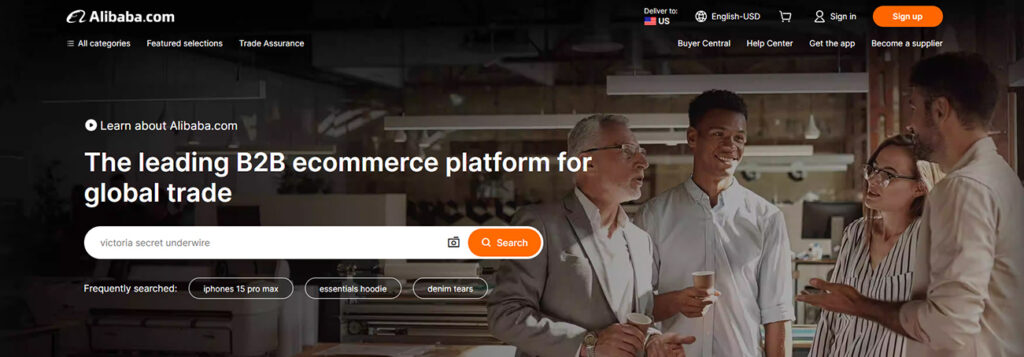
TL;DR – From Alibaba to Amazon in 8 Steps
Here’s a quick breakdown on how to go from a product idea to a live FBA listing by using Alibaba. Scroll down for the full walkthrough, plus tips, templates, and first-hand advice from my own experience.
- 1. Research the product. Focus on demand, competition, and realistic margins. Use a product research tool to confirm people are actually buying it and that you can make a profit after shipping, fees, and the cost of goods.
- 2. Vet your suppliers. Use Alibaba’s filters:
- Verified Supplier – business has passed third-party checks
- Gold Supplier – paid membership that adds accountability
- Trade Assurance – secure, escrow-style payments
- 3. Reach out to 3–5 suppliers. Ask for pricing for multiple quantities, lead times, and their product catalog. Use our message template to sound professional.
- 4. Order samples. Get one from each serious supplier and inspect them for quality, packaging, and accuracy. You can often negotiate to have the sample fee credited to your first bulk order.
- 5. Negotiate terms. Once you’ve picked a supplier, confirm price per unit, production timelines, and shipping method. Make sure your supplier offers DDP shipping (they handle customs, taxes, and delivery to your door).
- 6. Place your first order. Keep your quantities low to start, but high enough to test market demand. Limit deposits to 30–50% and always pay through Alibaba with Trade Assurance.
- 7. Book a quality inspection. Use a service like QIMA to check the goods before they leave the factory. Catching any problems here can help you avoid major issues in the future.
- 8. Choose your shipping method. Send inventory to a 3PL or prep center for labeling and final checks, especially on your first shipment. Direct-to-Amazon is faster but riskier when it’s your first time working with a supplier.
Alibaba Basics for Amazon Sellers
If you’re planning to launch a private label product or buy inventory in bulk, Alibaba is where most Amazon sellers start. It’s a B2B marketplace that connects you with factories, mostly in China, that manufacture just about anything you can imagine.
I’ve used it for years to source products for my own brands. What makes it so powerful is the direct access it gives you to suppliers. You’re not buying from middlemen or distributors, you’re going straight to the source. That’s why the prices often look surprisingly low compared to retail or even wholesale.
You can search by keyword, browse by category, or even upload a photo of a product you like. From there, it’s about narrowing down the results and starting conversations with suppliers. The process can feel a little foreign at first, but once you get the hang of it, it’s one of the best ways to find profitable products for your Amazon store.
Alibaba vs AliExpress: What’s the Difference?
People often confuse Alibaba with AliExpress, but they serve completely different purposes.
Alibaba is built for businesses that want to buy in bulk, customize products, or build private label brands. Most listings require a minimum order quantity (MOQ), which means you’ll need to purchase a set number of units to place an order. Prices are usually negotiable, and you’re expected to message the supplier to work out the details before anything is confirmed.
AliExpress, on the other hand, is more like a Chinese version of Amazon. You can buy one unit at a time, there’s no negotiation, and most products are pre-made. It’s a Business-to-Consumer platform, so it’s better for testing a product or ordering samples quickly without going through a full sourcing process.
I sometimes use AliExpress to check out potential product ideas before reaching out to suppliers on Alibaba. But if you’re planning to launch an Amazon FBA business, Alibaba is the platform built for that.
Feature | Aliexpress | Alibaba |
Target Audience | B2C (Individual Consumers) | B2B (Businesses) |
Purpose | Wholesale sourcing & manufacturing | Retail shopping |
Pricing | Wholesale/bulk pricing | Retail pricing |
Communication | Direct supplier negotiation | Minimal seller interaction |
Minimum Order Quantities | High (typically 50-1000+ units) | Low (often 1 unit minimum) |
Why Is Alibaba “So Cheap” & Is It Legit?
The first time I browsed Alibaba, I saw prices so low I figured something had to be off. It’s normal to feel that way. When you see products listed for $1 or $2 a unit, it’s easy to assume it’s a scam. But once you understand how the platform works and why the pricing is structured that way, it makes a lot more sense.
First, you’re buying at the source. Alibaba connects you directly with manufacturers, which cuts out middlemen and retail markups. Second, China’s massive manufacturing infrastructure and supply chain make production incredibly efficient. And third, Alibaba runs on a wholesale model. The more units you buy, the cheaper your price per unit becomes.
That said, just because the prices are low doesn’t mean it’s a scam. Alibaba is a legitimate platform used by millions of businesses around the world. But like any marketplace, it has its share of bad actors. In my experience, most problems happen when buyers skip their due diligence or rush into deals. If a branded product looks suspiciously cheap, it probably is. And if a supplier won’t answer your questions or pushes for a quick deal off-site, that’s a red flag.
Can You Legally Resell Alibaba Products on Amazon?
Yes, you can legally resell Alibaba products on Amazon, as long as you’re careful about what you’re buying and who you’re buying it from. Most sellers on Amazon source their inventory from Chinese manufacturers, and Alibaba is one of the most popular ways to do that.
The problems start when people try to resell branded items without permission. I’ve seen new sellers make this mistake by ordering products with logos or characters they don’t have the rights to, thinking it’s easy money. It’s not. That shortcut can get your Amazon account shut down, your shipment seized at customs, or even land you in legal trouble.
To stay safe, stick to unbranded or OEM products. Better yet, look for opportunities to build your own private label brand. That gives you complete control and avoids the risk of violating someone else’s trademark. Alibaba makes it easy to source these types of products, and most suppliers are used to working with Amazon sellers.
Trademark, Patent & Compliance Checks
Before you buy anything from Alibaba, make sure you’re not stepping on someone else’s intellectual property or breaking product laws in your country. Amazon takes this seriously, and so do customs authorities.
Start by avoiding any product that looks like it’s copying a well-known brand. If you see logos, characters, or designs that feel too familiar, skip them. Even if the supplier claims it’s legit, the risk isn’t worth it. Amazon doesn’t need proof to shut down your listing or your account, they’ll just do it.
If you’re developing your own product, ask about exclusivity. Some suppliers will give you a regional exclusivity agreement or even help you secure a design patent. If you’re going custom, get your branding molded right into the product itself. That way, the supplier can’t easily sell your design to someone else.
On the compliance side, ask for certifications. This is especially important if you’re selling in a regulated category. Things like electronics, kids’ toys, and anything food-related usually have specific requirements you’ll need to follow. A reputable supplier should be able to show you documentation like ISO, BSCI, or FDA approvals. Don’t just take their word for it. Look them up, verify their business license, and always ask for product samples before ordering in bulk.
How to Do Product Research on Alibaba for Amazon FBA
Before I ever message a supplier on Alibaba, I want to be confident that I’ve found a viable product idea. That means checking demand, understanding the price potential, and asking whether I can actually compete in the market. Most failed products happen because sellers rush through the product research phase. Make sure you take the time to find a product that is profitable, fills a clear need, and won’t lead to problems with quality control or compliance.
Start by validating demand. Tools like Google Trends, Amazon’s Best Sellers list, or even niche forums can help you spot ideas that have consistent demand. You can also use a product research tool like Helium 10 or Jungle Scout to dig into search volume, estimated sales, and competition. If you’re comparing tools, check out my breakdown of the best Amazon product research software to see what fits your budget and workflow.
Once you’ve got a few ideas, work backwards. Can you source the product at a low enough cost? Is the competition manageable? Will it pass the safety and compliance checks in your country?
As a general rule, I look for products priced between $40 and $100. That range gives you enough margin to cover Amazon fees, shipping, and ads while still making a profit. I prefer products that are lightweight, simple, and built to last. In other words, things that are less likely to break in transit or get returned.
Remember, you don’t need a groundbreaking new invention. What you need is a product that solves a real problem with proven demand.
How to Spot a Good Product on Alibaba
The table below breaks down the key things I look for and the red flags I avoid when researching products on Alibaba. If you want a deeper walkthrough of the full research process, check out our complete guide to Amazon FBA product research.
| Criteria | Green Flags | Red Flags |
|---|---|---|
| Demand | Consistent demand with room for new sellers | Low or unclear demand, limited search interest |
| Competition | Moderate competition, no dominant brand | Saturated niche or dominated by big players |
| Selling Price | $75–$150 range (allows room for profit) | Under $20 or over $200 (thin or risky margins) |
| Size & Weight | Small, lightweight, fits in shoebox | Bulky, heavy, or awkward to ship |
| Durability | Sturdy, few moving parts, low return risk | Fragile, easily damaged in transit |
| Seasonality | Evergreen or global appeal | Short seasonal window (e.g., Christmas-only item) |
| Branding Potential | Generic or OEM, easy to private label | Branded or trademarked without rights |
Calculating Landed Cost & Target Margin
Once you’ve found a product with strong potential, the next step is figuring out whether the numbers actually work. That starts with calculating your landed cost, which is the true cost of getting each unit from your supplier’s warehouse onto Amazon. It’s where a lot of new sellers go wrong by not taking the time to understand each factor.
Here’s the basic formula I recommend using:
Landed Cost = (Product Cost + Shipping + Customs Duties + QC + Insurance + Prep Fees) ÷ Total Units Ordered
If you’re using DDP shipping, and I strongly recommend you do so, many of those costs are baked into one quote. But even then, don’t forget to include sample costs, inspection services, and any FBA prep fees like labeling or bundling. These smaller charges add up fast, and they can quietly destroy your margin if you skip them in your math.
Once you’ve nailed down your estimated landed cost per unit, apply what’s often called the 3X rule. If your landed cost is $10, your target retail price should be around $30. That gives you room for Amazon fees, advertising costs, and leaves you with a profit. It’s not a perfect rule, but it’s a good starting point for deciding whether a product is worth pursuing.
I’d rather pass on something that “might work” than sink money into an order that never had the margins to begin with. Let the math make the decision. Feelings won’t cover your losses.
How to Buy from Alibaba and Sell on Amazon: Step-by-Step
Getting your first product from Alibaba to Amazon can feel overwhelming, but the process becomes manageable when you break it down into smaller steps. From vetting suppliers to shipping your final inventory, each stage gets you closer to making your first sale. Here’s a quick guide on how to go from idea to inventory with confidence.
1. Vetting Suppliers Like a Pro
Once you’ve found a potential product, the first step is to find a reliable supplier. Alibaba makes it easy to search, but not every listing is trustworthy. That’s why I always start by filtering out low-quality or questionable suppliers before ever sending a message.
When you run a product search on Alibaba, use the filters in the left sidebar to focus on suppliers that meet these basic requirements:
- Trade Assurance – This filter guarantees that every supplier you see offers Alibaba’s secure payment system. When you place an order through Trade Assurance, your payment is held in escrow until you confirm the goods were delivered on time and meet your quality expectations. It’s the safest way to pay on Alibaba.
- Verified Supplier – This badge means Alibaba or a third-party service has reviewed and verified the supplier’s business license, factory location, and capabilities. It’s a basic legitimacy check that’s worth having.
- Gold Supplier – A paid membership that requires the supplier to pass a detailed vetting process. The yearly fee is high enough to deter scammers, and it’s often a sign that the business is more established and transparent.
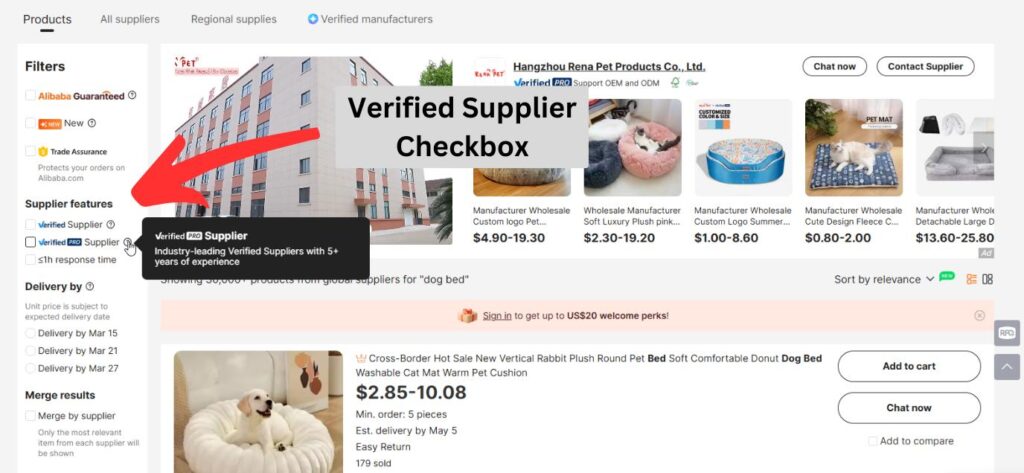
Once you’ve narrowed things down, click into the Company Profile on each listing. You’ll find important details there: how long they’ve been on Alibaba, which countries they export to, and what certifications they hold. Suppliers that regularly ship to the U.S. or Europe tend to follow stricter quality standards, which makes your life easier when selling on Amazon.
Next, look at their product catalog. If they specialize in a single category, like kitchen tools or fitness gear, they’re likely a manufacturer. If they’re selling everything from power tools to baby clothes, you’re probably dealing with a trading company. Trading companies aren’t always a dealbreaker, but they often mean higher prices and slower communication.
Once you’ve identified a potential match, review their reviews. Alibaba doesn’t allow suppliers to delete bad reviews, so read both the good and bad. Look for consistent patterns in quality, communication, and delivery speed. If a supplier has only been active for a few months or suddenly has dozens of glowing reviews all at once, that’s often a sign the reviews were faked, and you should consider looking elsewhere.
First Message Template to Contact Suppliers
Once you’ve found a supplier that looks promising, reach out with a clear message that shows you’re a serious buyer. Here’s a template you can customize:
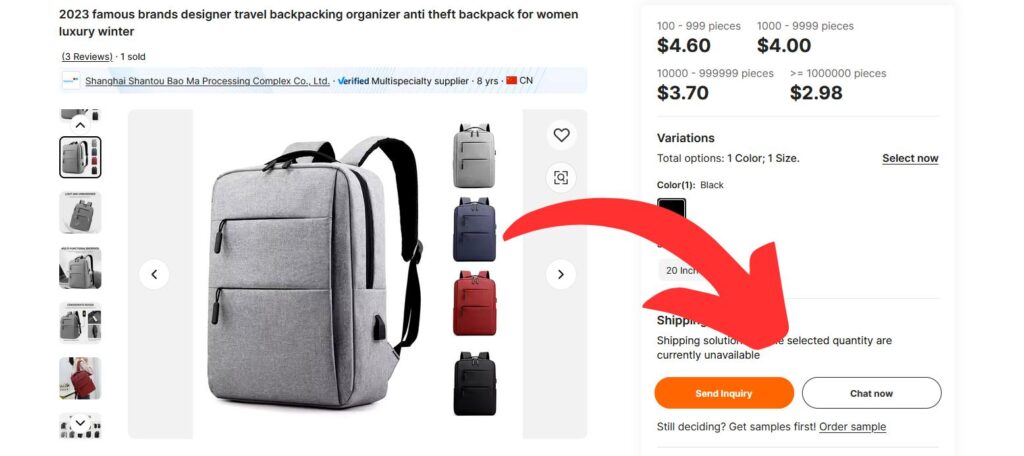
Subject: Inquiry About [Product Name] – Bulk Order
Hi [Supplier’s Name],
My name is [Your Name], and I’m a buyer from [Your Business Name]. We specialize in selling [Your Niche, e.g., fitness gear, pet products, etc.] and are interested in carrying some of the items you offer.
Could you please provide pricing and availability for [Product Name] in quantities of [500, 1,000, and 5,000 units]? Also, I’d appreciate it if you could share your product catalog, lead times, and MOQ.
Looking forward to your reply!
Best regards,
[Your Name]
[Your Business Name]
Once you get a reply, continue evaluating their communication. A good supplier responds quickly, answers questions clearly, and doesn’t avoid details. If they push you to pay outside of Alibaba or become vague about product specs or lead times, move on. It’s not worth the risk.
2. Order Product Samples
After you’ve spoken with the supplier and confirmed the basic product details, the next step is to request a sample. This is your first chance to see the actual product and catch potential issues before placing a larger order.
When you request a sample, be as specific as possible. Include the exact dimensions, materials, color, packaging preferences, and any branding you want applied. If you’re considering different variations, like multiple colors or sizes, ask for one of each so you can compare. Use Alibaba’s messaging system to keep all communication and details in one place.

Sample shipping usually runs around $40 to $50, though it can vary depending on the size and destination. Most suppliers won’t charge for the product itself, but you’ll need to cover the freight. If you’re serious about moving forward, ask if they can deduct that shipping cost from your first order. Many suppliers are open to it.
Once the sample arrives, review it closely. Check the build quality, materials, functionality, and how it’s packaged. This is often the highest quality version you’ll get, so if anything feels off now, assume it’ll be worse in the bulk order. You should also test for durability or compliance issues, especially if your product falls into a regulated category.
If something doesn’t match what was promised, bring it up with the supplier before going forward. And if a supplier won’t send a sample at all, that’s usually a good reason to walk away.
3. Negotiating Price, MOQ & Incoterms
Once you’ve reviewed your sample and you’re happy with the quality, it’s time to negotiate your first bulk order. That means talking about price, quantity, payment terms, and shipping. Most suppliers expect you to negotiate. What really matters is how you do it.
Before you start, make sure that you have requested quotes from multiple suppliers through the RFQ feature. This gives you a baseline for what similar products cost. If you’ve received better pricing elsewhere, mention it. I’ve even sent side-by-side comparisons in Excel before. It’s a quick way to show you’re serious and well-informed.
Ask questions about their pricing. What drives their cost, raw materials, labor, tooling, packaging? Understanding where their price comes from helps you identify where there’s room to move. You can also use currency shifts to your advantage. If your currency is stronger than the yuan, ask which exchange rate they’re using.
Suppliers are generally more flexible if they believe you’re building a real business, not just testing a one-off product. You don’t need to pretend you’re placing massive orders, but do let them know you plan to reorder if the product performs well. Most will offer better pricing or lower minimums if they see potential for a long-term customer.
Now let’s break down two key parts of this negotiation, MOQ and Incoterms, since both can significantly affect your cost and flexibility.
What Is MOQ?
MOQ stands for Minimum Order Quantity. This is the smallest number of units a supplier is willing to produce or sell per order. You’ll see MOQs listed on most Alibaba product pages, but don’t assume they’re fixed. Many suppliers are open to lowering the MOQ for first-time buyers, especially if you frame your order as a trial run with the potential for repeat business.
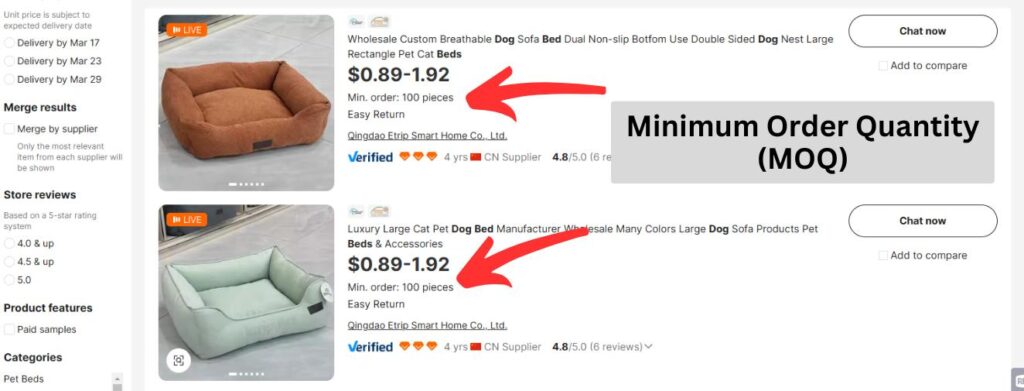
If the MOQ is too high, ask directly if they’re flexible. You might offer to meet in the middle or suggest a smaller order now in exchange for a larger reorder later. On the other hand, offering to buy more than the MOQ can give you leverage for better pricing or higher-quality packaging.
During your product research, use Alibaba’s filters to set an upper limit on MOQ. This helps avoid wasting time with suppliers whose production scale doesn’t fit your current goals.
What Are Incoterms?
Incoterms are international shipping terms that define who’s responsible for each stage of the delivery process, including freight, customs, duties, and delivery. In almost all cases, especially if you’re new to importing, I highly recommend negotiating for DDP (Delivered Duty Paid).
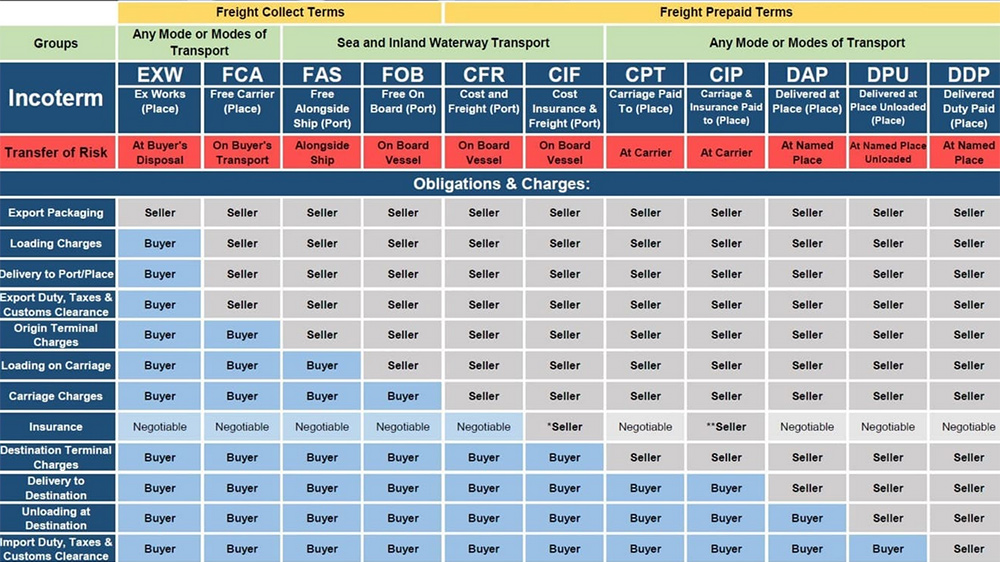
With DDP, the supplier handles everything from their door to your delivery address, including customs paperwork and taxes. It’s not the cheapest option, but it removes most of the risk and prevents surprise fees down the line. You won’t need to coordinate with customs brokers or figure out how to get your shipment from the port to Amazon.
Always confirm early whether the supplier offers DDP. Many will quote EXW (Ex Works) or FOB (Free on Board) by default because it makes their pricing look cheaper, but both of those terms push more cost and responsibility onto you. If a supplier can’t offer DDP or seems unsure about what’s included, it’s usually a sign to move on, or involve a freight forwarder to help manage shipping on your end.
4. Securing Safe Payment
After you’ve agreed on price, MOQ, and shipping terms, the next step is paying your supplier and protecting that payment.
The safest way to pay on Alibaba is by using Trade Assurance. This is their built-in escrow system that holds your funds until you confirm the goods have arrived and meet your expectations. If the supplier misses deadlines or sends a product that doesn’t match the agreement, you can file a dispute and request a refund.
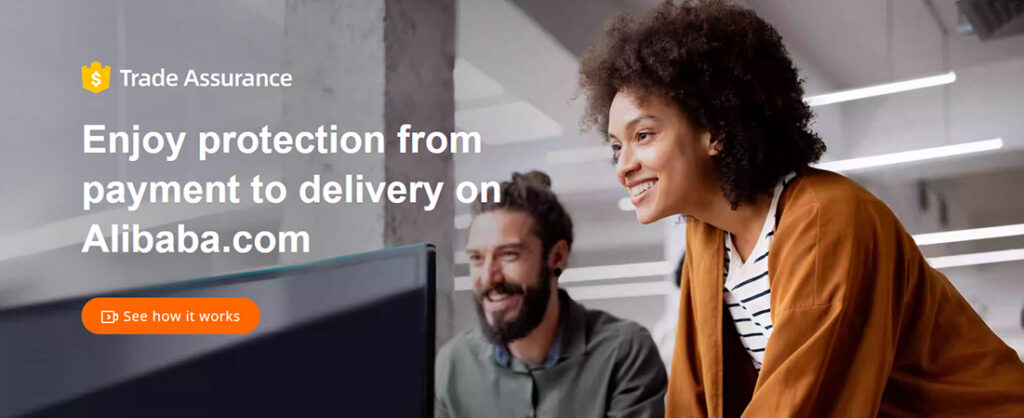
Besides Trade Assurance, the next best options are Alipay, PayPal, and credit/debit cards, all of which are processed through Alibaba’s platform. PayPal offers the most protection, but the fees can be quite high. For smaller orders under $1,000, credit cards are convenient, but they can become expensive on larger transactions.
Whatever option you choose, never pay outside of Alibaba. If a supplier asks you to send money via Western Union, direct bank transfer, or to a personal account, it’s a major red flag. Real suppliers stick to the platform because it protects both sides of the transaction.
Legitimate suppliers typically ask for a 30–50% deposit, with the remainder due before shipment. That’s normal. What’s not normal is being pressured for 100% upfront or having the agreed price change after you’ve sent money. Lock in all terms in writing before paying a deposit.
5. Inspecting Your Order Before Shipment
Before your order leaves the factory, it’s smart to confirm that the final units match the quality, specs, and packaging you agreed to, because fixing mistakes after shipment is expensive and slow.
That’s why I strongly recommend hiring a third-party inspection service. These companies go to the factory, open random boxes, check for defects, verify labeling, and take photos or videos so you can review the results before the order gets shipped out. Some also provide detailed reports on workmanship, packaging, and compliance with your order specs.

I use QIMA for all of my inspections and have had great results. Other sellers I know have also used SGS or TÜV Rheinland. I’ve also heard good things about services like Kanary and Noviand, which offer inspection either at the factory or at a logistics center before your goods ship.
Even if you’re not planning to hire an inspection service, you should still ask your supplier for clear photos and videos of the finished units being packed. Make sure they show the labeling, the box count, and how everything is palletized, especially if it’s going to Amazon FBA.
When a supplier knows you’ll be verifying the order before the final invoice is paid, it keeps standards high. It’s one of the simplest ways to hold them accountable and avoid potential issues down the line.
6. Booking Freight & Clearing Customs
For most shipments, ocean freight offers the best balance of cost and capacity. Just know it typically takes 4 to 6 weeks door-to-door, so you’ll need to factor that into your lead time. If you’re shipping to Europe, rail freight is another option that moves faster than sea and costs less than air.
If you’re using DDP (Delivered Duty Paid), as covered earlier, confirm that your supplier is covering the full journey, customs, duties, and delivery to your address. If they’re unsure or don’t have much experience, I recommend working with a professional freight forwarder instead.

There are lots of options available, but one tool I highly recommend is Freightos.com. It’s a freight marketplace where you can compare quotes from multiple vetted forwarders in real time. You can book, track, and manage your shipments directly through their platform, and they offer Amazon-specific services like palletization, labeling, and customs support. Having the ability to compare rates for dozens of forwarders at one time makes it a great tool.
Lastly, protect your shipment. Cargo insurance is cheap and worth every penny if something gets lost or damaged. And always plan around Chinese holidays like Lunar New Year, when factories and ports shut down for weeks. Poor timing can stall your entire supply chain, even if everything else is in place.
7. Optional: Using a 3PL or Amazon Global Logistics
Once your inventory is packed and ready to go, you’ll need to decide how it gets from your supplier to Amazon’s warehouse. For most sellers, that means choosing between direct shipping to Amazon FBA, using a third-party prep service (often called a 3PL), or going through Amazon’s own freight program, Amazon Global Logistics.
While direct-to-Amazon shipping sounds simple, I don’t recommend it for your first shipment. This is your first real bulk order with a new supplier, and it’s worth inspecting the products before they reach Amazon, either yourself or through a prep center. It’s the only way to catch quality issues, mislabeling, or packaging mistakes before Amazon gets involved. Once it hits their dock, you could face added fees or even a rejected shipment.
A 3PL, short for third-party logistics provider, is a company that handles storage, inspection, labeling, and shipping on your behalf. They act as a checkpoint between your supplier and Amazon. These services can make sure your products are FBA-compliant, apply FNSKU labels, bundle multi-packs, and send everything to the correct fulfillment center. It adds a bit of time and cost, but it saves a lot of stress if anything needs fixing.
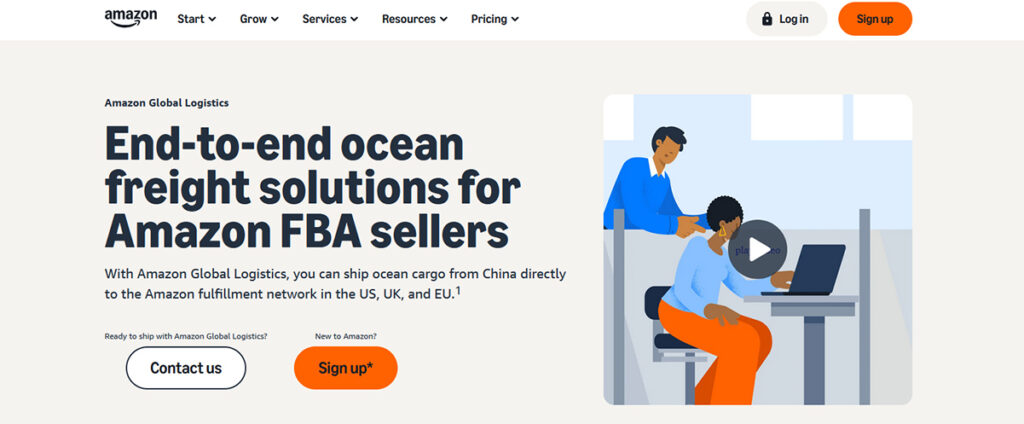
A final option is Amazon Global Logistics, which is available through Seller Central. It’s Amazon’s built-in freight program that handles international shipping, customs clearance, and delivery to FBA. Just be sure your supplier is still following Amazon’s prep and labeling requirements. AGL does not handle quality control or product inspections.
Common Risks & How to Avoid Them
Sourcing from Alibaba can absolutely work, but it comes with some risks. If you’re just getting started, this section will help you spot the most common scams and missteps before they hit your bottom line.
Scams, Quality Issues & Recourse
Scams on Alibaba usually fall into a few predictable patterns. A common one is the supplier sending a great-looking sample, then cutting corners on the full production run. Another is the “phantom supplier” that collects a deposit and disappears. You may also run into price changes after the deposit, with the supplier claiming a sudden rise in raw materials.
One of the easiest ways to avoid these situations is to only work with suppliers who allow factory inspections and respond clearly to detailed questions or inquiries. If they’re vague or dodging questions early on, that’s usually a preview of what’s to come. And if a supplier won’t agree to basic verification steps like a video call or third-party QC, I highly recommend walking away.
If something does go wrong and you’re working with a legitimate supplier, you still have a few options. Detailed documentation, including saved messages, contracts, and proof of payment, gives you leverage in any dispute. Disputes are harder to resolve when conversations are spread across email, WhatsApp, or WeChat. Keep everything centralized.

Lastly, if the process feels too risky or time-consuming, some sellers turn to full-service sourcing companies, like Kanary, that can manage communication and verify production on-site. It’s not required, but for larger orders or custom projects, it can add a layer of protection.
Regulatory & Tax Pitfalls
Customs clearance requires detailed documentation, including a commercial invoice, packing list, and customs declaration. If you’re importing into the U.S., you may also need a customs bond, especially for higher-value shipments. Products in regulated categories, like food, supplements, or electronics, often need additional permits or agency approvals.
For Amazon FBA, it’s essential to prepay all duties and taxes. If charges arrive unpaid, Amazon will most likely reject the shipment. That’s why I recommend working with a licensed customs broker. They handle classification, compliance, and prevent the kinds of mistakes that can delay your shipment.
To simplify things, make sure your freight quote includes every cost, including duties, taxes, and handling fees. Services like Freightos are useful here because they break everything down upfront. If you want an extra tip, some freight providers offer bundled services that include prep, customs clearance, and FBA delivery in a single quote. It costs more than the standard service, but it can give you peace of mind and help you avoid surprise fees and delays.
Frequently Asked Questions (FAQs)
Does Amazon Accept Alibaba Invoices for Brand Registry?
The bad news is that Amazon does not accept Alibaba’s order confirmation forms as valid invoices. However, the good news is it’s usually fairly easy to get a commercial invoice from the supplier you found on Alibaba. This invoice should include product details (such as name, description, and quantity), per-unit cost, total purchase amount, and the supplier’s business information (name, address, and contact details).
Besides the invoice, you may also need packing slips describing the contents of each parcel and a bill of lading listing what was shipped. Most suppliers are familiar with these requirements and can provide the necessary documents. If they’re unsure, your freight forwarder can often help create or verify the paperwork. By ensuring you have the correct documentation, you can avoid delays and meet Amazon’s requirements for selling on their platform.
What is the safest way to pay a supplier on Alibaba?
The safest way to pay on Alibaba is through Trade Assurance, Alibaba’s free escrow service. It holds your payment until you confirm that your order was delivered on time and matches your agreed quality standards. To stay protected, always pay through Alibaba’s platform and avoid off-platform transfers.
How long does shipping from Alibaba to Amazon FBA take?
From the time you place your order to the moment it arrives at an Amazon FBA warehouse, the process typically takes 90 to 120 days. This includes product manufacturing, quality inspections, international freight, customs clearance, and final delivery. For bulk orders, ocean freight is most common and usually takes 30 to 40 days door-to-door.
Which Incoterm is best for Amazon FBA shipments?
In almost every situation, DDP (Delivered Duty Paid) is the best Incoterm. It includes shipping, customs clearance, and delivery to your address. DDP simplifies the process and avoids surprise fees, making it ideal for beginners who don’t want to manage logistics or hire a customs broker.
How many units should I order for my first Alibaba shipment?
For your first Alibaba order, start small, typically between 100 and 500 units, depending on the product and supplier. This gives you a chance to test product quality, confirm you’re supplier is legit, and learn the sourcing and shipping process without risking too much capital. Always order samples first before committing to a full production run.
Is Alibaba-to-Amazon Sourcing Right for You?
Sourcing from Alibaba doesn’t need to be risky or confusing. If you take the time to research your product, verify your supplier, test samples, and set clear shipping terms, you’ll avoid most of the common mistakes new sellers make.
Whether this is your first shipment or you’ve done a few before, the goal is simple: get quality inventory into Amazon without delays or surprises. Taking the time to do things right the first time will save you money and stress later.
Recommended Articles
- How to Start an Amazon FBA Business in 7 Simple Steps
- Brand Registry on Amazon: A Comprehensive Guide for 2025
- Amazon FBA Product Research – An Easy 6-Step Guide to Finding Profitable Products
Levi Adler is an experienced Amazon seller, e-commerce specialist, and the founder of Levi’s Toolbox. With over a decade in the trenches selling on Amazon and managing his own Shopify stores, Levi writes from his own experience. Sharing what worked, what flopped, and the strategies he wishes he’d known sooner. When he’s optimizing listings or managing ad campaigns, you’ll find Levi hitting mountain bike trails or hanging out with his two huskies, Emma and Scout.
